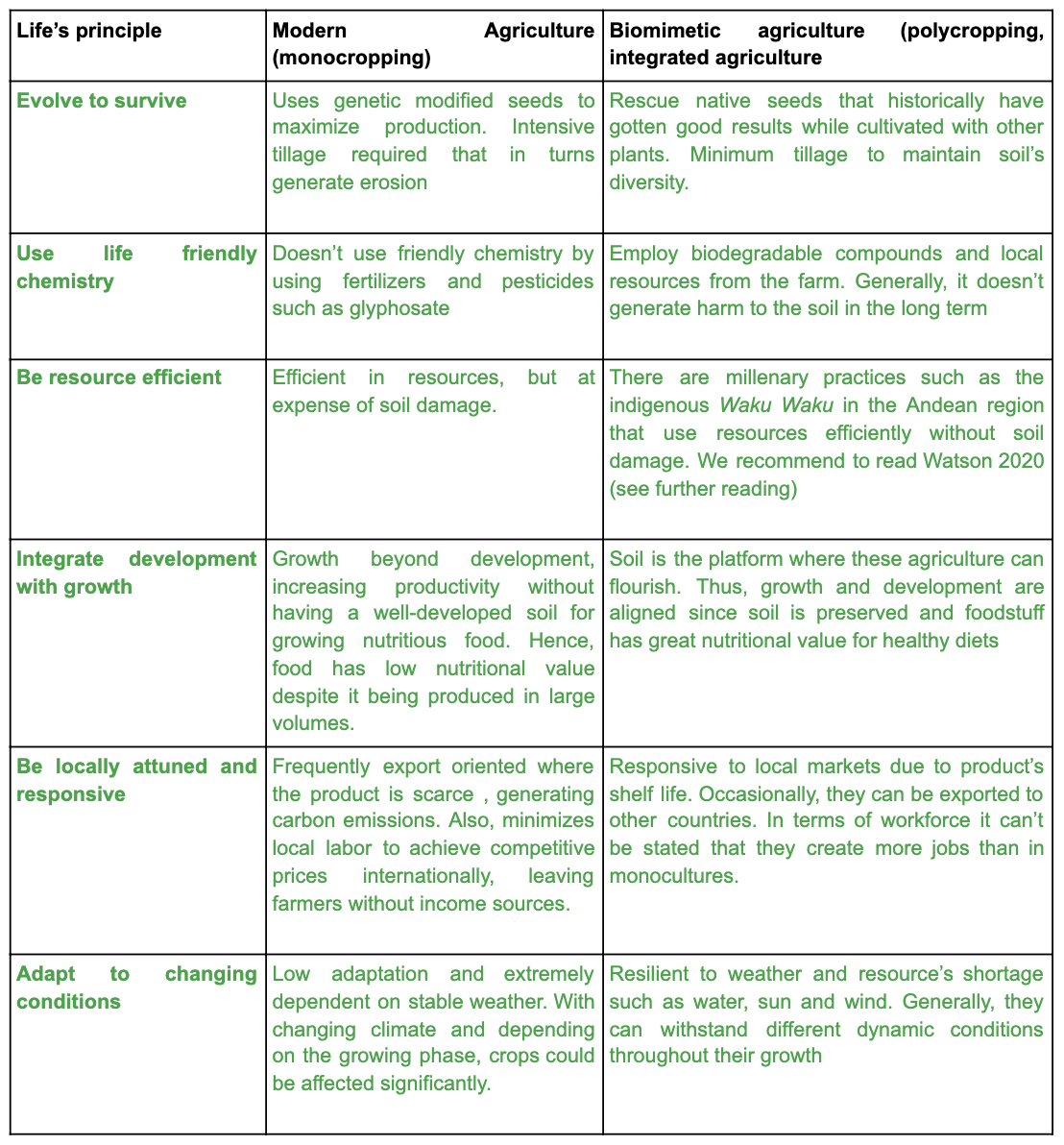Do we solve it today or tomorrow?
A topic of attention for food and nutrition sustainability of the future global population is undoubtedly arable soil and its quality. Even more important will be to understand how to use it to ensure the resource for future generations. Biomimicry can guide us on this sustainable path.
It is a subject that appears tangentially to our lives, perhaps because as time passes we focus on urban areas and thus progressively lose our relationship with the countryside and nature. From time to time, when going out for lunch on a Sunday outside the city, going on a plane crossing a land swath, crossing the fields on a train or going on vacation we are able to contemplate the wonder of rural areas, its diversity (not in all cases) and opportunities. Our view crosses forests, moors, rivers, deserts and lagoons while we continue in motion. And that progressive image enchants and relaxes us. At some moment we even question it: Living in the countryside, away from the stress and congestion of cities, growing food, raising livestock and in short improving our well-being. When we see the farmers working, moving the cows, their houses blowing smoke through the chimneys and producing food from various plants and animals, we create a good photo to go back home. In there, a few hours after the idea arrived and the image dissipates. Even more worrisome, we could not relate that that field of sunflowers, the farmer, the cow, the tractor, the soil that contains it and the water that meanders the crop are essential for urban subsistence.
The earth’s land area comprises 149 million square kilometers, of which 71% corresponds to habitable land, 10% to glaciers and 19% to arid lands (sandy and salt deserts, exposed rocks, beaches and dunes). Part of the success of the former is having a suitable soil for agriculture, the growth of lush forests and the capability upon which cities are built. Basically, it is the support on which our civilization stands and much of where the terrestrial natural world exists. Its deterioration, in turn, can have a significant negative effect on the planet’s welfare. On one hand, if deforestation continues (between 1700 and 2016 the forests have decreased from 57% of the habitable land to 38% in 2018)the soil will erode and we will not be able to count on resources that serve different purposes, including absorbing carbon dioxide emitted by several of our industries through trees, flowers and plants. A great challenge for the decades to come is how we can conserve and reforest different regions of the planet. On the other hand, if our agricultural practices, especially those based on monoculture, continue in the following decades through the use of fertilizers and pesticides based on fossil fuels and methods such as intensive tillage, the soil will become more arid. Our food security would become fragile and progressively less resilient. The problem we face is a paradox: Modern agriculture allows us to feed a large percentage of the human population (7. 8 billion inhabitants by 2020 compared to just 1 billion in 1900), increasing its productivity through the unsustainable use of soil and non-renewable resources such as fresh water. However, banning its practice would create food shortages, prices would skyrocket, and it won’t be possible to deliver nutritious food to the majority of the people. How can we then achieve a balance to solve the short and long term at the same time?
Yet, not all the news are negative. At least our goal at Greenroad is to provide solutions within realistic possibilities. A very interesting study carried out by Daniel Evans recently shows us that we still have time to make a positive impact change to protect fertile lands. Through a soil analysis in 255 locations around the world, the study reviews how many years it would take to erode 30 centimeters of fertile soil (black soil) based on current erosion rates for three scenarios: Soils without vegetation as the worst case scenario, soils that are managed with conventional practices and finally soils that are worked with sustainable practices for conservation purposes. Results are surprising: In the first case, 34% of the vacant soils could last 100 years before being completely eroded. As for land with conventional uses that includes monocultures, 16% of them would last 100 years. Finally, in the scenario of soils managed with conservation objectives, 7% of the soils can last for 100 years. The study also shows that 39% of these soils would last more than 10. 000 years, generating a very optimistic scene. Hence, we have a great opportunity to solve our paradox.
Biomimicry, forest conservation and agriculture are closely linked, since we are intrinsically working with nature. Rather than emulation, we face in this case a minimal intervention to increase the benefits for human beings without risking survival. From a global point of view, the first advice from the biomimetic perspective is to change the extractive vision that we have in agriculture, for a regenerative one in which we produce food while conserving the diversity of nature. Second, we must prefer local production over that of other countries, which implies a larger carbon footprint among other drawbacks. Third, we must perform reforestation on forest and bare lands to increase fertile soil.
In order to use soils for food production without damaging its composition, two alternatives can be considered : First, groups of people who want to make the countryside their home and wish to subsist with what they produce and sell surpluses to local markets. In this case, permaculture and agroecology present excellent opportunities, with successful stories ranging from 0. 5 to 10 hectares. They also include profits of 40% with incomes between 150. 000-250. 000 USD per hectare (Fortier, 2014). Yet, this does not solve the problem of global nutrition. Secondly, the author Jocanovic (2017) recommends “integrated agriculture”, for larger scales. This is defined by European standards as a system where organic food, fiber, balanced food and renewable energy are produced using resources in a sustainable way , avoiding harmful agents.
As the reader can deduct, there are viable solutions to feed ourselves and prevent soil erosion. In this table we present some ideas of how agriculture models follow or not life’s principles . We hope they are useful!

We recommend the following sources for further reading
- Baumeister, D (2014). Biomimicry resource handbook.
- Fortier, J. M. (2014). The market Gardener : A successful grower handbook for small scale organic farming. New society publishers, Canada.
- Evans D. L et al (2020). Soil lifespan and how they can be extended by land use and management change. Environmental research letters, Vol 15 0940b2.
- Jocanovic (2019). Biomimicry in Agriculture: Is the ecological system design model the future Agricultural Paradigm. Journal Agricultural Environmental Ethics. Vol 32, pp. 789- 804.
- Watson, J (2020). Lo-Tek. Design by radical Indigenism. Waru Waru Agricultural terraces of the Inca, Peru. Taschen, New York.

